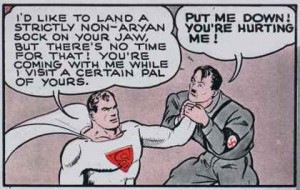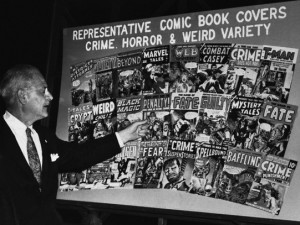Germany announced that they will lift the across-the-board ban on swastikas in video games in favor of a more nuanced approach, similar to that of how they handle Nazi imagery in movies. The shift in policy signals an appreciation for video games as culturally important works. Felix Falk, managing director of The German Games Industry Association, said in response to the shift in the law,
“We in the games industry are concerned about the tendencies we see towards racism, anti-semitism and discrimination. We are strongly committed to an open, inclusive society, to the values laid out in the German constitution, and to Germany’s historical responsibility. Many games produced by creative, dedicated developers address sensitive topics such as the Nazi era in Germany, and they do so in a responsible way that encourages reflection and critical thinking. The interactive nature of games makes them uniquely qualified to spark contemplation and debate, and they reach younger generations like no other medium can.”
The plan is to evaluate each game that depicts symbols of unconstitutional organizations individually, to determine whether the ‘social adequacy clause’ applies. The social adequacy clause, allows for symbols of unconstitutional groups to be used in media, given that the symbols serve an artistic or scientific purpose, or depict real events from the past or present.
In recognition of this improved policy, we thought it would be a good time to revisit how far comics have comics have come in Germany. Take a look at A Brief History of Comics Censorship in Germany from the CBLDF archives!
“Smut and Trash:” A Brief History of Comics Censorship in Germany
The United States wasn’t the only country that harbored a crusade against comics this past century. Germany, too, has had its own sordid history with the medium, complete with public fears over an alleged increase in juvenile delinquency and subsequent censorship laws designed to curb youth consumption of what the Nazi party called during World War II “schmutz und schund” (smut and trash). Today we take a brief look at the history of comics censorship in Germany and the interesting ways it paralleled much of the United States’ own battle to cure what many considered a social epidemic.
When the Nazi party took power in Germany in 1933 one of Adolf Hitler’s biggest initiatives was to purify German society of everything vulgar and low class. Along with religion and race, this effort also extended to the realm of art as well as consumerist culture, and caught in the cross-hairs of Hitler and his associates’ social “cleansing” was comic books. One of the comics most vehemently attacked by the Nazi party during World War II, and really a starting point for propaganda that fostered a decades-long fear of funny books in the country, was Joe Shuster and Jerry Siegel’s Superman.
Not only were the creators of the character the sons of Jewish immigrants, but as WWII progressed and Germany more prominently appeared in comics as an evil force to defeat, the Nazi party took it upon themselves to demonstrate the physical, mental, and ethical weaknesses of Superman and his creators, and how the beloved character demonstrated explicitly the ways comics were tangibly retarding the minds and morality of the American population—things the Nazi party hope to discourage in Germany by outright banning the sale and production of comic books.
 “Jerry Siegel, an intellectually and physically circumcised chap who has his headquarters in New York, is the inventor of a colorful figure with an impressive appearance, a powerful body, and a red swim suit who enjoys the ability to fly through the ether,” begins 1940s article printed in the SS weekly newspaper, Das Schwarze Korps. It continues:
“Jerry Siegel, an intellectually and physically circumcised chap who has his headquarters in New York, is the inventor of a colorful figure with an impressive appearance, a powerful body, and a red swim suit who enjoys the ability to fly through the ether,” begins 1940s article printed in the SS weekly newspaper, Das Schwarze Korps. It continues:
The inventive Israelite named this pleasant guy with an overdeveloped body and underdeveloped mind “Superman.” He advertised widely Superman’s sense of justice, well-suited for imitation by the American youth…
[We] really ought to ignore these fantasies of Jerry Israel Siegel, but there is a catch. The daring deeds of Superman are those of a Colorado beetle. He works in the dark, in incomprehensible ways. He cries “Strength! Courage! Justice!” to the noble yearnings of American children. Instead of using the chance to encourage really useful virtues, he sows hate, suspicion, evil, laziness, and criminality in their young hearts.
To the Nazi party, Superman was not only mentally inferior and morally corrupt, but with these deficits of characters the consumption of the comics was literally rotting away the minds of America’s youths. “Jerry Siegellack stinks,” concludes the article. “Woe to the American youth, who must live in such a poisoned atmosphere and don’t even notice the poison they swallow daily.”
Although written by the Nazi Minister of Propaganda himself Josef Goebbels for a warring nation, much of these same fears of costumed superheroes like Superman would be echoed by the infamous child psychologist Dr. Fredric Wertham and become fodder for his book Seduction of the Innocent and his quest to censor comics.
Citing Dr. Paul A. Witty, a professor of education at Northwestern University, Wertham writes that superhero comics “present our world in a kind of Fascist setting of violence and hate and destruction. I think it is bad for children,” he goes on, “to get that kind of recurring diet … [they] place too much emphasis on a Fascist society. Therefore the democratic ideals that we should seek are likely to be overlooked.” With arguments like this, Wertham duped a whole nation into believing that comics from the superhero to horror variety were the root cause in the moral degeneration of a generation and a leading factor in the increase in youth crime and delinquency.
 In 1954 a Senate Subcommittee Hearing was held in which it was determined that measures needed to be taken to regulate the content printed in comics. Indirectly born out of the hearing was the industry-sponsored Comics Code Authority and Comics Code, which not only helped censor numerous comics off of the newsstand but for decades would stand as the basis for what comics were considered appropriate and others obscene in the eyes of the law.
In 1954 a Senate Subcommittee Hearing was held in which it was determined that measures needed to be taken to regulate the content printed in comics. Indirectly born out of the hearing was the industry-sponsored Comics Code Authority and Comics Code, which not only helped censor numerous comics off of the newsstand but for decades would stand as the basis for what comics were considered appropriate and others obscene in the eyes of the law.
While the Comics Code was the U.S. comics industry’s own effort to stave off government regulation, Germany saw its own laws established in the 1950s to fight the dissemination of “publications that endanger youth.” The seed of fear that comics corrupt children may have been planted in the Nazi era, but it would find its most fertile soil in a struggling post-war Germany.
With the conclusion of WWII, there was an underlying antagonism between Germany and the United States. Part of this came in the form of an explicit distaste for anything imported from America into the country—in particular American comic books. “This intertwining of text and images with this variety of grotesque figures and adventure stories struck Germany like a tsunami,” says Bernd Dolle-Weinkauff, head of the Research Institute for Young Adult Books at Johann Wolfgang Goethe-University in Frankfurt. “And it was first brought here in the post-war era by American GIs. The fast story-telling of tales of adventure with the wild characters that [for example] Disney comics presented were a red flag for many.”
During the war, comics were “smut and trash.” After the war, they were said to be the cause of an increase in youth illiteracy and most importantly crime in Germany. As Paul M. Malone writes, “the postwar influx of American comics had only convinced German parents and authorities that the victors possessed a far more impoverished culture than the vanquished.”
In response to this public fear over the mental well-being of a new generation, in 1953 Germany adopted the law which prohibited the distribution of harmful writings to young persons (Gesetz über die Verbreitung jugendgefährdender Schriften), and in 1954 established the Federal Department for Writings Harmful to Young Persons (Bundesprüfstelle für jugendgefährdende Schriften or BPjS).
It wasn’t just superheroes and adventure comics that would become the target of this new government agency. Comics like Tarzan were targeted for their alleged ill-effects on the minds of youth. The BPjS claimed that comics would affect young people in a “nerve-inflaming and brutalizing way” and “transport them into an unreal world of lies.” Comics were “the result of a degenerate imagination” and as such needed to be indexed and regulated, much like how the Comics Code regulated comics in the United States.
By the ’60s, though, comics would become less of a target of censors in Germany as people realized the tenuous connection between comics and juvenile delinquency; the country adopted a fond taste for characters like Donald Duck and Mickey Mouse who the public determined not to be too detrimental to youths.
That said, similar to the Comics Code Authority, organizations like the BPjS would continue to exert some influence over media content well into the 2000s—the BPjS becoming the BPjM (Bundesprüfstelle für jugendgefährdende Medien) to accommodate new forms of media like television, movies, music, and video games. Although the Comics Code was formally abandoned in 2011, the BPjM still actively functions in Germany today with the goal to protect minors against materials that “endanger their process of developing a socially responsible and self-reliant personality.”
Help support CBLDF’s important First Amendment work in 2018 by visiting the Rewards Zone, making a donation, or becoming a member of CBLDF!
Contributing Editor Caitlin McCabe is an independent comics scholar who loves a good pre-code horror comic and the opportunity to spread her knowledge of the industry to those looking for a great story!
